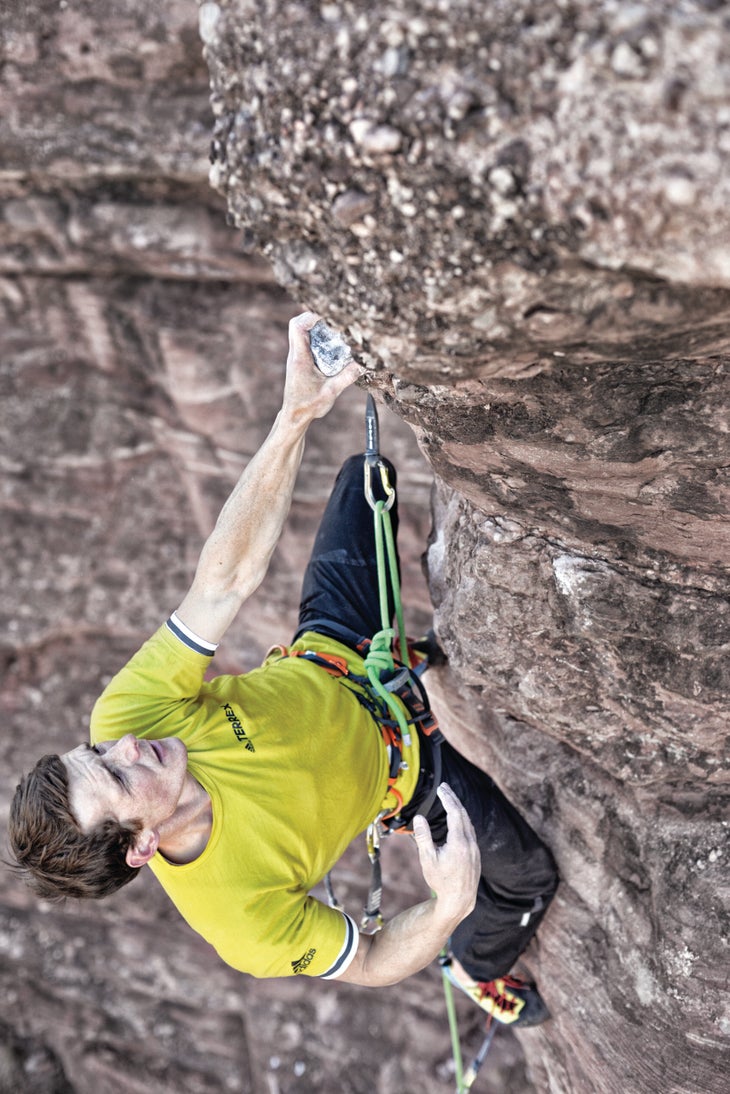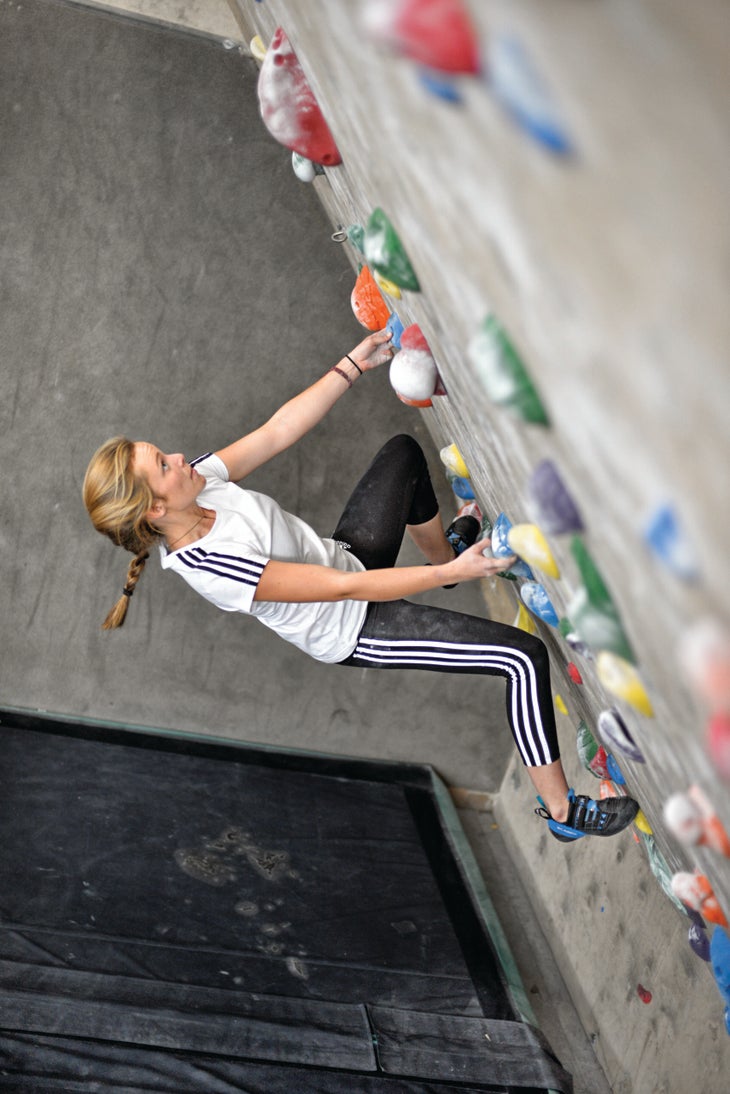Heading out the door? Read this article on the new Outside+ app available now on iOS devices for members! Download the app.
There are many ways to go about improving your endurance and skills for leading, yet many climbers continue to make the same mistakes, slowing down their rate of improvement. A basic approach will often prove to be more effective than a highly complex one. All climbers need endurance, and there’s no such thing as too much of it. Even if you boulder exclusively, having endurance enables you to do more moves in a given day, and finish each problem that much fresher.
Let’s start with some tips and a basic overview. The top nine tips for any endurance training regimen are:
- Vary the intensity. Do sessions where you’re focused on shorter climbs with harder moves for strength endurance and sessions where you focus on longer easier climbs for long endurance.
- Make a plan. Start with long endurance to build base fitness and then move to strength endurance (usually in combination with strength).
- Mix up the methods. Don’t just do routes; do circuits, boulder intervals and so on.
- Combine climbing-based training with cross-training. Supportive aerobic fitness plays a crucial role, so use your rest days accordingly.
- Use an interval structure, where the grade (or work difficulty) and rest times are fixed and you aim for a certain number of repeats/climbs.
- Train specifically for weaknesses and goals. For best results simulate the requirements of projects or train on steeper angles if that’s what you find toughest.
- Finish sessions with endurance exercises. Even if your forearms are pumped and your fingers are burnt, you may still be able to do some worthwhile endurance exercises for the core and arms at the end of the session.
- Set goals. Write down your current capacity for repeating routes in single, double, triple and quadruple sets. Then write down what you hope to be doing halfway through your planned endurance phase (e.g., in three weeks’ time), and again at the end of the phase (e.g., in six weeks’ time).
- Stay focused on technique and the mental element. Improvements in endurance are often as much to do with skills as physical elements. Maintain a constant awareness for relaxed, efficient movement and mind control during your sessions. For best results, switch between different climbs, rather than lapping the same route or circuit.

Endurance Training Methods
Routes
For beginners and intermediates, there is a huge value to training endurance by leading routes, as this enables skills to be developed in combination with fitness. Toproping is for beginners and not recommended for anyone who wishes to progress at the higher grades. Routes can be climbed individually or in multiple sets to achieve different training effects. Use the guidelines given for strength endurance and long endurance to determine how many consecutive laps you need to do, and note that this also depends on the height of the lead wall you’re training on. To climb routes in multiple sets, lower off quickly but safely between each one, pulling the rope down and then moving on to the next one.
Auto-belay machines are also suitable for both strength endurance and long endurance training but are less preferable to leading.
Circuits
Circuits are pre-planned, continuous sequences of moves, commonly 15 to 80 moves long. They provide one of the best and most convenient methods for endurance training, as you don’t need to rely on a belay partner. If you’ve only trained endurance on routes then using circuits for the first time will give your climbing a major kick-start. Some climbing gyms offer purpose-designed circuit walls, which feature pre-set color-coded circuits, but if you don’t have access to one then you can set your own circuits on an appropriate bouldering wall or woody. The aim is to climb around, either in a circle, figure-8 or upwards, downwards and sideways movement. Avoid rests or cruxes and make the climbing equally blended. Use the guidelines given previously for the number of moves, rests and repeats for strength endurance and long endurance.
Boulder Intervals
Contrary to popular misconception, bouldering walls are fantastic tools for endurance training, provided you know the protocol and are mindful of other climbers who may wish to use the same space. The basic principle is for problems to be grouped together in blocks and climbed back-to-back, either with no rest, or very brief rests in between. A longer rest is then taken between blocks and the blocks are repeated a fixed number of times. Boulder intervals tend to lend themselves more to training strength endurance, rather than long endurance. For strength endurance, do three to five boulders in a row and for long endurance do eight to 15 boulders in a row.
Pro Tip: Down-climbing For Endurance
One approach, which works well for long-endurance training is to down-climb an easierroute on the same line. Unclip on the way down and reverse lead if you feel confident or just top-rope back down, stay on the wall at the base of the route and have your belayer pull the rope through.
Stick/Point Training
Whether we care to admit it, most of us gravitate toward sessions we find comfortable—both physically and mentally. Rock is rarely so generous, especially when it comes to onsighting. Even if you are familiar with the rock type, you never know what’s coming next and the route may dish out an uncomfortable surprise.
To break out of the common trap of climbing in your comfort zone, add a rock-specific onsighting element to your endurance sessions—you’ll need a motivated and like-minded training partner. Take turns using a stick to point each other around randomly made-up sequences on the bouldering wall.
The idea is to maximize the element of awkwardness, for example by suddenly going quiet and leaving your partner stranded in an awkward position, desperately awaiting instruction. Give the person hard moves and sustained sections, interspersed with awkward resting positions, and aim to be as unpredictable and sadistic as possible. After all, your friend will soon be returning the favor! However, don’t overcook it to the point that your partner keeps falling. The longer you keep the climber on the wall, the more pain you will force him or her to endure. It’s no surprise that few climbers do this type of training, as it is arguably the hardest that exists for climbing. However, to prepare you for early-season rock, there is nothing to match it. Use the training guidelines given previously.
Pace Training: Slow It Down
We all tend to sprint up gym routes faster than we climb on rock. Outdoors the holds are harder to see and the sequences trickier to read, so at times it pays to force yourself to climb slowly in the gym. Pause for three to five seconds for each hand move to simulate the rhythm of a typical sport onsight. Alternatively, if you are preparing for trad, count for six to 12 seconds per move and then, every fourth or fifth move, pause for a minute regardless of the size of the holds. This exercise will improve your ability to shake out in awkward positions and remind you how it feels to fiddle in wires when you’re pumped out of your mind. For sport onsighting, stay on the wall for eight to 12 minutes and for trad stay on for up to 15 or 20. Climb up and down if necessary, using an easier route for the down climb, or lower off quickly, pull the rope and continue leading upward. It makes sense to use an auto-belay or climb around at random on an easy bouldering wall, provided you’re not hogging the space.
Campus Boards for Endurance
Campus boards are great for endurance training. Stronger climbers can go footless and train top-end strength endurance, whereas climbers operating from an intermediate level can train with feet on, and work both strength endurance and long endurance (aka anaerobic capacity or aerobic power). The main exercise is basic laddering, but you can spice things up with variations such as up and downs, where you go up one rung, return to the start and then go up one rung higher each time until you top out.
For strength endurance you need to be capable of performing between 12 and 30 repetitions, whereas for long resistance it will be between 60 and 150 reps. For long endurance it may make more sense simply to time yourself on the board rather than counting moves/reps. Clearly, the training variables will be rung size and spacing, and whether or not you go footless. The advantages of using a campus board for endurance are that the training is formulaic and easy to measure, and you can switch your brain off and go for the burn. The downside is that you won’t be training footwork and technique and the movements are repetitive, so you should never do the training for long stints (e.g., four or five weeks max).

Hangboards for Endurance
Hangboards are often categorized as strength-training tools; however, they can be equally effective for endurance and come into their own for quick home workouts when time is scarce.
